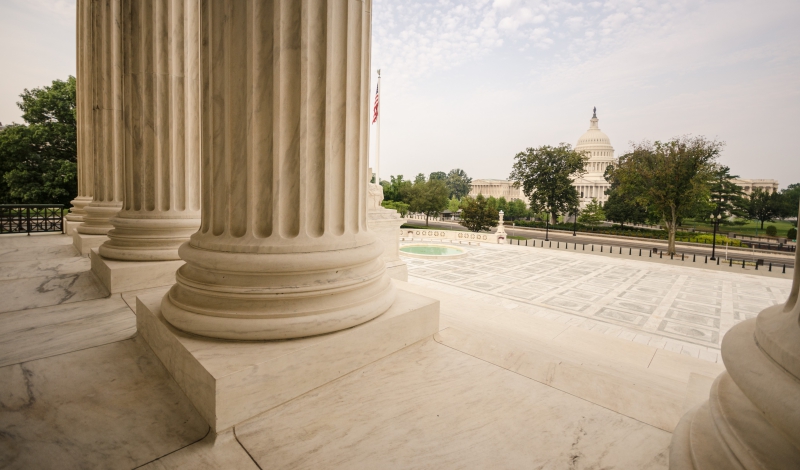
Scholars explain how courts have interpreted the Administrative Procedure Act to overlook racial discrimination.
The Administrative Procedure Act (APA) can protect Hawaii dolphins and small broadcasters from arbitrary, discriminatory decisions of federal agencies. But the APA does not offer racial minorities—or any protected class—refuge if agency decisions cause “disparate impacts,” discriminatory effects from apparently neutral policies.
In a recent paper, Stanford University researchers Cristina Isabel Ceballos, David Freeman Engstrom, and Daniel E. Ho explain how courts removed racial categories from the antidiscrimination principles of the APA. They contend that courts and policymakers should reinvigorate the APA to identify and prevent disparate impacts of agency actions.
Courts have used Section 704 of the APA to limit the statute’s reach in handling claims of discrimination. Section 704 precludes judicial review under the APA if a plaintiff’s claims have an alternative “adequate remedy” that addresses them under other statutory or constitutional grounds.
In a 1990 case known as Women’s Equity Action League v. Cavazos, the U.S. Court of Appeals for the D.C. Circuit found an “adequate remedy” for civil rights plaintiffs outside of the APA in Title VI of the Civil Rights Act, which prohibits discrimination in any program funded by the federal government. The plaintiffs in that case had argued that, under Title VI, the Department of Health, Education, and Welfare (HEW) should better oversee schools to prevent discrimination by race. Better oversight could involve cutting off funding to schools that discriminated or stepping up reviews of compliance and investigations of complaints.
But the court rejected any basis for holding HEW to a higher standard of enforcement of civil rights. First, the court held that plaintiffs could not challenge HEW oversight under Title VI. The Court read the statute to only permit lawsuits against funding recipients—not the federal agency funding those recipients. “Federal courts will not oversee the overseer,” the court noted.
Second, plaintiffs could not challenge HEW oversight under the APA because lawsuits against funding recipients—that is, the state and local entities receiving federal funds—constituted an “adequate remedy” under Section 704 of the APA.
Later developments, however, closed off pathways to alternative remedies for challenging discrimination, even in direct suits against federal, state, and local entities.
For example, the case of Alexander v. Sandoval—decided by the U.S. Supreme Court in 2001, 11 years after Women’s Equity—foreclosed lawsuits claiming disparate impacts. Sandoval restricted discrimination claims by private plaintiffs under Title VI to those involving intentional discrimination.
Ceballos, Engstrom, and Ho argue that the Supreme Court’s limitation on Title VI in Sandoval undermined the ability of Title VI to serve as a viable alternative to the APA. They conclude that “Sandoval effectively gutted private enforcement of disparate impact.”
Federal agencies have put in place many antidiscrimination regulations under the authority of Title VI, including rules targeting disparate impact. But private plaintiffs have no recourse when an agency is unable or unwilling to investigate and remedy disparate impacts.
Ceballos, Engstrom, and Ho advocate overturning Women’s Equity. They contend that Sandoval prevents Title VI from giving “adequate relief” for disparate impacts. Given the later Sandoval decision, the reliance of Women’s Equity on Title VI to turn away APA claims is no longer valid, argue Ceballos, Engstrom, and Ho.
Alternatively, if courts do not revisit Women’s Equity, Ceballos, Engstrom, and Ho recommend that courts limit the reach of Women’s Equity. They reason that Women’s Equity should only apply to claims against the overseer of a discriminatory state or local funding recipient, which raise the concern of the court “overseeing the overseer.”
Lower courts, however, have applied Women’s Equity to turn away direct challenges to practices that cause discriminatory impacts. For instance, the D.C. Circuit in Garcia v. Vilsack relied on Women’s Equity to dismiss claims that the U.S. Department of Agriculture discriminated against minority farmers in issuing loans.
Limiting Women’s Equity would allow private plaintiffs to bring suits claiming disparate impacts against the agency causing those discriminatory effects.
In addition to making these recommendations to the judiciary, Ceballos, Engstrom, and Ho offer proposals for Congress and the President to ensure that agency actions that result in disparate impacts involving protected classes receive sufficient review.
Congress could intervene with a statute mandating that agencies perform disparate impact analyses as well as mitigate differential effects. Two statutes already require analogous measures in the contexts of protecting the environment and small businesses. The National Environmental Policy Act requires “a detailed statement” of the environmental impacts of a regulation. And the Regulatory Flexibility Act ensures that agencies consider and minimize a regulation’s effect on small businesses. A new statute could require such statements and analyses of any differential impacts on individuals in protected racial and gender-based categories.
The President could also attend to reducing or eliminating such disparate impacts. One vehicle for ensuring consideration of disparate impacts is the White House process for review of rules by the Office of Information and Regulatory Affairs (OIRA), which oversees cost-benefit analyses.
In Executive Order 12,866, President Bill Clinton instructed OIRA and agencies to consider “distributive impacts.” President George W. Bush also included consideration of “distributional effects” as part of cost-benefit analyses, which may include impacts across classes such as race. And President Joseph R. Biden’s presidential memorandum on regulatory review solicits recommendations for “procedures that take into account the distributional consequences of regulations.”
Although perhaps promising strategies will emerge from the Biden Administration’s solicitation process, Ceballos, Engstrom, and Ho contend that OIRA review is inadequate because private parties cannot hold agencies accountable for upholding principles of antidiscrimination.
Their proposed solution calls for agencies—under the direction of a new executive order—to amend their rules implementing Title VI. These updated Title VI regulations could include a mandate for disparate impact assessments. Private parties would then have a pathway to hold agencies accountable by enforcing the agency’s own procedures under the APA.
Taken together, the proposals from Ceballos, Engstrom, and Ho would give the President, Congress, and the courts a clearer role in remedying “administrative law’s erasure of race.”



